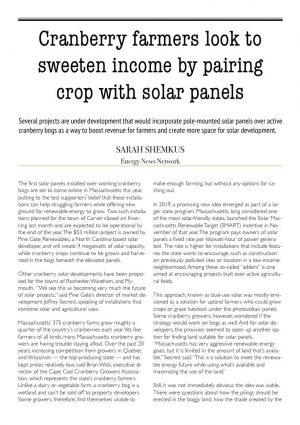 Several projects are under development that would incorporate pole-mounted solar panels over active cranberry bogs as a way to boost revenue for farmers and create more space for solar development.
Several projects are under development that would incorporate pole-mounted solar panels over active cranberry bogs as a way to boost revenue for farmers and create more space for solar development.
The first solar panels installed over working cranberry bogs are set to come online in Massachusetts this year, putting to the test supporters’ belief that these installations can help struggling farmers while offering new ground for renewable energy to grow.
Two such installations planned for the town of Carver closed on financing last month and are expected to be operational by the end of the year. The $53 million project is owned by Pine Gate Renewables, a North Carolina-based solar developer, and will create 9 megawatts of solar capacity, while cranberry crops continue to be grown and harvested in the bogs beneath the elevated panels.
Other cranberry solar developments have been proposed for the towns of Rochester, Wareham, and Plymouth.
“We see this as becoming very much the future of solar projects,” said Pine Gate’s director of market development Jeffrey Secrest, speaking of installations that combine solar and agricultural uses.
Massachusetts’ 375 cranberry farms grow roughly a quarter of the country’s cranberries each year. Yet, like farmers of all kinds, many Massachusetts cranberry growers are having trouble staying afloat.
Over the past 20 years, increasing competition from growers in Quebec and Wisconsin — the top-producing state — and has kept prices relatively low, said Brian Wick, executive director of the Cape Cod Cranberry Growers Association, which represents the state’s cranberry farmers. Unlike a dairy or vegetable farm, a cranberry bog is a wetland and can’t be sold off to property developers. Some growers, therefore, find themselves unable to make enough farming, but without any options for cashing out.
In 2019, a promising new idea emerged as part of a larger state program. Massachusetts, long considered one of the most solar-friendly states, launched the Solar Massachusetts Renewable Target (SMART) incentive in November of that year. The program pays owners of solar panels a fixed rate per kilowatt-hour of power generated.
The rate is higher for installations that include features the state wants to encourage, such as construction on previously polluted sites or location in a low-income neighborhood. Among these so-called “adders” is one aimed at encouraging projects built over active agricultural fields.
This approach, known as dual-use solar, was mostly envisioned as a solution for upland farmers who could grow crops or graze livestock under the photovoltaic panels. Some cranberry growers, however, wondered if the strategy would work on bogs as well. And for solar developers, the provision seemed to open up another option for finding land suitable for solar panels.
“Massachusetts has very aggressive renewable energy goals, but it is limited in the amount of land that’s available,” Secrest said. “This is a solution to meet the renewable energy future while using what’s available and maximizing the use of the land.”
Still, it was not immediately obvious the idea was viable. There were questions about how the pilings should be erected in the boggy land, how the shade created by the panels would affect crop productivity, and how the finished structure would disturb the existing cranberry plants.
To help address some of these concerns, the University of Massachusetts Cranberry Station, a research center devoted to maintaining the economic viability of cranberry farming, got involved early on. In 2019, researchers built plywood panels intended to emulate a solar installation on a section of active cranberry bog to see whether the shade would result in fewer or lower-quality berries.
“We definitely had a yield reduction, but there weren’t any big red flags that came up,” station director Hilary Sandler said. “Cranberries are a really good candidate because they are typically an understory plant so they don’t need a lot of sunlight to be successful.”
As plans moved ahead, Pine Gate had to find ways to adapt to the unfamiliar bog environment. Instead of supporting the solar array with conventional steel racking, the company devised a plan to use wood utility poles, which they expect to be more durable in the wet bog conditions. The poles will be driven as deep as 30 feet into the ground to ensure the installation remains stable.
Even as bog solar installations come online, developers and researchers will continue to learn and adjust.
The research station has plans to partner with five bogs to maintain an ongoing research project studying the impacts and results. For example, cranberry bog panels will be sited over a perennial crop, so some damage to existing plants is inevitable. Sandler and her team will track the extent of this damage and try out methods for mitigating it; adding extra sand to the bog, she theorized, could reinvigorate the plants to return them to full productivity more quickly. They will also be looking at whether panels can be spaced more closely together without lowering the cranberry yield significantly.
“There is a lot of thought going into how to do these things right,” said Iain Ward, a veteran cranberry farmer and solar consultant who will be operating the parcels in Carver for Pine Gate. “In five to six years, we’re going to have new best practices specifically tailored to growing crops under dual-use arrays.”
Solar will never be a solution for every farm, developers and growers agree. Some bogs don’t get enough sunlight to make solar a viable option, and others aren’t located close enough to transmission infrastructure to easily hook a solar installation into the grid, Wick said.
There is, nonetheless, broad agreement that the strategy holds significant potential for growers and solar developers alike.
“It’s absolutely something that everyone should evaluate,” Ward said. “It’s not the answer for cranberries, but it is an answer.”
by
Originally published
by Energy News Netwrk
May 28, 2021


